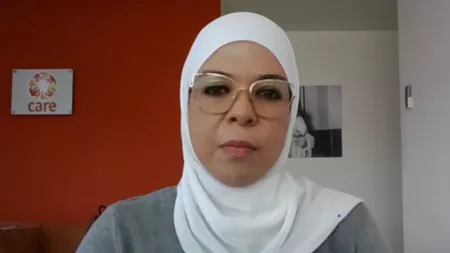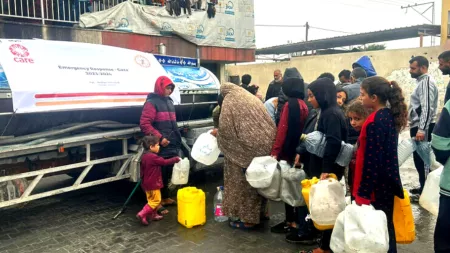Over 2 million people in Gaza – almost the entire population - are dependent on aid for survival.
However, only very limited aid deliveries are allowed into the enclave. Despite many Gazans facing starvation, only about 95 trucks can enter every day, compared to around 500 before the war.
Besides the limited amount, delivering aid in Gaza is extremely difficult. CARE West Bank and Gaza Country Director Hiba Tibi explains the massive challenges our teams face to provide some relief to people's suffering and why only a ceasefire can ultimately save lives.
What is the situation of CARE’s aid arriving in Gaza?
Since October, CARE has been able to support over 250,000 people with over 153,000 liters of water, helped 68,000 people through our mobile clinics, distributed over 3,000 dignity kits to women and girls, and made sure that over 11,000 people have the necessary tools and items to fix broken tents and shelters.
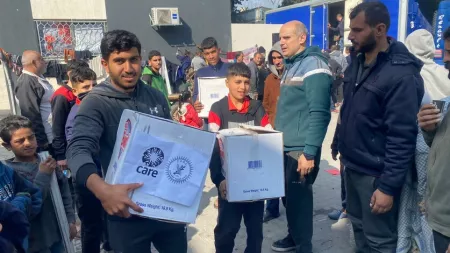
CARE has been in Gaza since 1948, and we are lucky to have local partners we have worked with for many years. They are tirelessly distributing aid to families who have lost everything during this war.
Whenever possible, CARE is working with suppliers within Gaza who still have supplies in their warehouses. This is how we were able to deliver bottled water, thousands of hygiene kits, and medicine during the first weeks when it was not possible for us to get trucks across the border.
Unfortunately, a lot of the humanitarian warehouses have been damaged or destroyed, and the roads between the different locations are damaged and under constant threat of bombardment.
Some of the items that are much needed are no longer available in Gaza, which is why we also have trucks going from Cairo in Egypt across the border into Gaza. So far, CARE has been able to get 20 truckloads across, carrying a total of 14,650 hygiene kits (750 kits per truck) and reaching 85,000 people. Six additional trucks are on their way. However, the process of getting aid into Gaza from Egypt is long and arduous.
Why is it so difficult to get aid from Egypt into Gaza?
All the aid we deliver to Gaza must come through Egypt. We either import the goods to Egypt or buy them there directly, whenever possible.
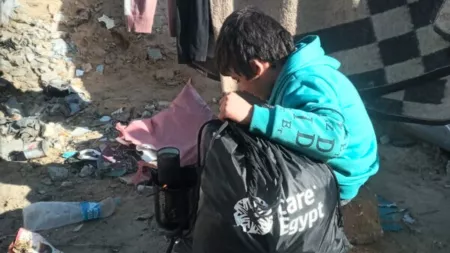
Fortunately, we have a big and experienced team in Cairo who could help us with setting up the systems and procedures required to get aid to people as quickly as possible. The Egyptian Red Crescent, a partner humanitarian organization, manages the trucks on behalf of the international community. As CARE, we provide different supplies such as hygiene kits, tools for fixing damaged shelters or food.
The Red Crescent then arranges for the goods to go to the border in Rafah, through the inspection process, and then cross into Gaza. From Cairo, the trucks must go through the Sinai Peninsula. There are multiple checkpoints.
Every single item in our trucks will be scanned and checked multiple times by Israeli and Egyptian authorities.
The Egyptian trucks cannot cross the border, so what happens is that in Rafah everything will be unloaded, scanned again, then reloaded onto our Palestinian trucks and brought to our warehouses. Often our partners also pick up the goods at the border with smaller trucks and take them to their warehouses. Getting the aid from Cairo to Gaza can take between three and 20 days.
What are the main hurdles to relief once aid has entered Gaza?
Our CARE staff and partners have been doing an incredible job. They know the situation, they know the existing suppliers, they know what people most need, and how we can get the assistance to them. But the challenges they are facing are enormous, even once the aid has crossed the border. Inside Gaza, there is a huge shortage of trucks. Only 120 trucks are operating inside Rafah. So, for every single truck that arrives from Cairo at the border and cannot cross, one of the trucks in Rafah has to come and pick up the goods, going back and forth from the border to deliver the assistance to people.
This takes a lot of time, especially because the roads have been damaged by airstrikes, and the streets in Rafah are incredibly congested. 1.4 million people are jammed into an area that is approximately half the size of Liechtenstein.
The streets are full of people, tents, and horse carts. People are increasingly tense and desperate as they see their loved ones die of diseases, hunger, or bombings. Masses of people complicate distributions. Thankfully our partners have worked in Gaza for many decades. They know the people and usually ride on top of one of our trucks; they talk to the big crowds, asking them to make space and explain to them how we deliver our assistance.
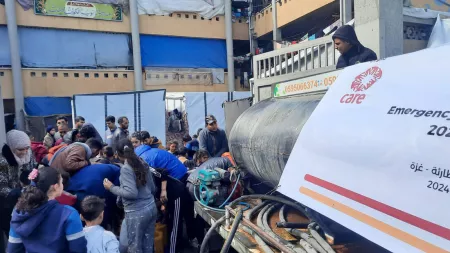
Constant telecommunication blackouts are another big issue, making it tricky to make simple phone calls and organize the delivery of assistance. Another serious challenge is the lack of security and the continuation of hostilities and bombardments. Our staff are risking their lives every day as they work to help others.
How is CARE keeping our staff safe?
Nowhere in Gaza is safe, unfortunately. CARE and partner staff live amidst the bombing, having had to flee their own homes.
They live in shelters for displaced people, often sharing tiny tents or rooms with dozens of family members or even strangers. Our Emergency Coordinator Saaed told us recently that his children beg him every morning not to leave the house. They fear for his life. Ultimately, the main thing we can do is make sure that our staff know that they should only go out when they feel okay to do so. We absolutely understand if they decide to stay home, particularly when receiving security alerts to avoid certain areas.
Our partners are exposed to huge risks, especially when driving to distribute the aid in schools, hospitals, and other shelters outside the city center. In the North, where CARE is one of only three international organizations still able to operate, unexploded ordinance is a huge risk, and everywhere in Gaza fighting and bombings are ongoing.
Ultimately, the only way we can ensure our staff and all other Palestinians in Gaza are safe is a ceasefire.
Our biggest fear right now is that attacks on Rafah will intensify. This would put the lives of our colleagues and hundreds of thousands of people in more danger, but it would also mean that we cannot get any assistance into Gaza from Egypt, and it would make any sort of aid delivery way too dangerous.
How does CARE ensure aid is getting to the people who need it the most?
During every distribution, our partner staff handle the goods, count the items, take the names of those who are receiving aid, and make sure people can provide feedback or share complaints. They ensure women, children, the elderly, and people with disabilities have access to the aid distributions. Our CARE staff help coordinate these distributions and monitor the process.
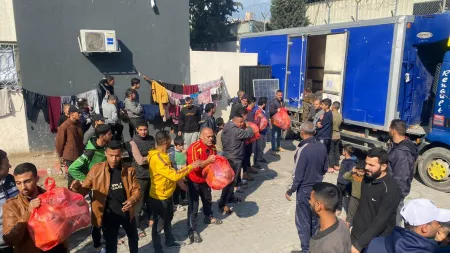
Families who live in the official shelters that are run by the UN and other organizations are registered, which gives us their names. Outside these formal shelters, we work with community elders to verify the names of families. The people we deliver aid to in Gaza are in desperate need of assistance – there is nothing they do not need. The situation is absolutely dire, with more than 2 million people at risk of dying of disease and hunger even if they have survived the bombings and attacks.
It is our humanitarian mandate to ensure that we help them, especially given the scale of the public health catastrophe that is unraveling.
